Chapter 17. From Kalmar to Gotland [September 5, 1347]
Cultural Explanations
 |
Chapter 17. From Kalmar to Gotland [September 5, 1347] Cultural Explanations |
|
|
In this chapter Bávlos reaches Gotland and sees a play about the Virgin. | ||
| Kalmar, ships, and Gotland; Virgin Mary with infant Jesus |
In this chapter, Bávlos travels southeast across Sweden to the trading city of Kalmar, where he boards a ship bound for Gotland. Arriving in Visby on the Feast of the Nativity of Our Lady (September 8), he witnesses a medieval drama performed in the Virgin's honor.
Bávlos is now beginning to learn a Germanic language, Swedish. Unlike Sámi and Finnish, Swedish marks gender: i.e., we like to specify whether the person we're talking about is a he or a she. Languages don't have to do this, by the way: people get by just fine in Finnish and Sámi without specifying whether the person they're talking about is a man or woman. Usually, people figure it out from context, or they ask if they really want to know. But one can talk for quite a long time nowadays about a doctor or lawyer or administrator and never know if the person referred to is a man or woman. English, by the way, had some centuries during which it had no separate terms for he and she either. The Old English terms he and hie had grown so similar to one another in sound that people could no longer distinguish them. The word she was somehow invented after some centuries, possibly borrowed from Irish. At any rate, Finns will often mess up he/she pronouns when speaking English and it causes Americans no end of amusement. Bávlos, looking at the situation from his own language's point of view, finds the Germanic obsession with gender strange and comical, especially as gender is applied to everything else, including land, tables, books, and rocks.
Bávlos arrives in Visby, the capital of Gotland. Long a vital trading city of the Baltic, Visby is today a quiet and picturesque little city, that is annually the site of one of Europe's largest medieval reenactment festivals. During that festival, the city becomes again as international and humming with activity as it must have been in the fourteenth century, at its height of trading influence.
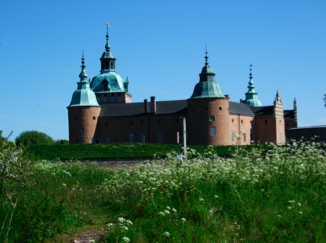 |
| Castle at Kalmar; this structure postdates the fourteenth century, but is sited over an earlier building. |
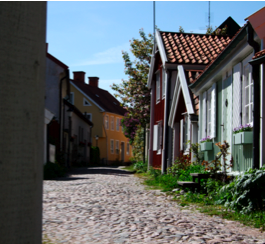 |
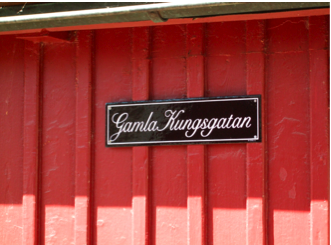 |
One of the few preserved medieval streets |
in Kalmar, "Old King's Street" |
 |
| A Kalmar sunset |
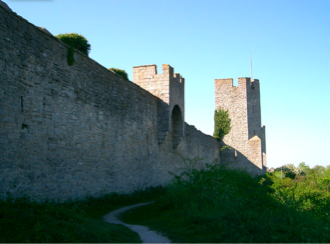 |
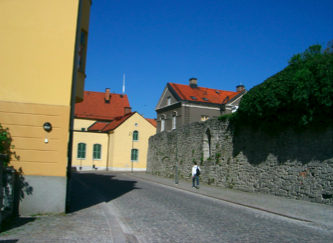 |
| Visby city walls and town |
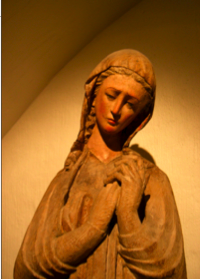 |
| A particularly loving image of the Virgin preserved in a Gotlandic church |
In Visby, Bávlos gets a chance to hear a medieval liturgical drama in honor of the Virgin Mary. The text used here is my rather close translation of the oldest surviving liturgical drama in any Scandinavian language, the text bearing the Latin title De uno peccatore qui promeruit gratiam [Of a sinner who received grace]. This play survives in a manuscript dating from 1492, and can be found in print in G. E. Klemming's Sveriges dramatiska litteratur till och med 1875: Bibliografi (Stockholm: P.A. Norstedt och Söner. Pp. 79, 1-6). All of the events recounted in the play--the knight's repenting, his conversation with St. Procopius, his pleading with the Virgin, his attempted suicide, the Virgin's snuffing and finally agreeing to help, Christ's irritation at being asked to forgive the knight, and Mary's motherly guilt trip on her divine son are all directly (and word-for-word) from the medieval drama.
Of course, medieval dramas seldom had much in the way of stage settings, so I filled out the chapter using what I know about medieval liturgical drama from other sources. In England, such dramas were always performed by men alone: often a particular guild or confraternity would own and perform a particular play, either on the saint's feast day or as part of a wider festival, e.g., during Holy Week. In France, both men and women performed on stage, and no one knows for certain what the practice was in Scandinavia. I opted to follow the British model, and have the Virgin played by a teenaged boy.
You will notice that the players move from positions on a raised stage (where they speak serious lines) to street-level scenes (which are often comedic). The play as it survives does not contain such directions about staging, but I have surmised these from what I learned studying one of the few other medieval dramas to survive from the region, the Danish martyr play Ludus de Sancto Kanuto duce [A play about Duke Saint Knud], which I translated and wrote about with my late great colleague, Prof. Niels Ingwersen in the volume Sanctity in the North: Saints, Lives, and Cults in Medieval Scandinavia.(Ed. Thomas A. DuBois. Toronto: University of Toronto Press, 2008).